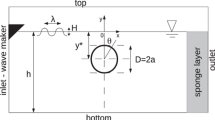Abstract
The problems of a solitary wave passing over rectangular cylinders have been analysed. The numerical simulation is based on the full nonlinear two-dimensional Navier-Stokes equations which are solved by the finite difference method. The free surface is dealt with by the Volume of Fluid method (VOF). Results for a solitary wave passing over a single cylinder are compared with the experimental data of Seabra-Santos, Penouard and Temperville[2] and better agreement is obtained than those obtained from the long wave equation based on the potential flow theory. Results are also given for two cylinders with different gaps.
Similar content being viewed by others
References
Cooker MJ, Peregrine DH, Vidal C, Dold JW. The interaction between a solitary wave and a submerged semicircular cylinder.J Fluid Mech, 1990, 215: 1–22
Seabra-Santos FJ, Penouard DP, Temperville AM. Numerical and experimental study of the transformation of a solitary wave over a shelf or isolated obstacle.J Fluid Mech. 1987, 176: 117–134
Madsen OS, Mei CC. The transformation of a solitary wave over an uneven bottom.J Fluid Mech, 1969, 39: 781–791
Djordjevic VD, Redekopp LG. The fission and disintegration of internal solitary waves moving over two-dimensional topography.J Phys Oceanogr, 1978, 8: 1016–1024
Ohyama T, Nadaoka K. Analysis of disintegration phenomena of nonlinear wave train passing over a submerged dike.J Civil Engng Society of Japan, 1992, 450/II-20: 31–40
Wan DC, Miao GP, Dai SQ. The VOF method for study of wave run-up and breaking on a sloping structure.J of Hydrodynamics, Ser B, 1997, 9(4): 88–96
Hirt CW, Nichols BD. Volume of fluid (VOF) method for the dynamics of free boundaries.J Comput Phys, 1981, 39: 201–225
Nichols BD, Hirt CW, Hotchkiss RS. SOLA-VOF: A solution algorithm for transient fluid flow with multiple free boundaries. Los Alamos Scientific Laboratory, 1980, LA-8355
Wang YX. Numerical simulation of the process of wave breaking in the front of vertical wall.Communication of Chinese National Key Laboratory, 1993, 3(6): 553–559 (in Chinese)
Wan DC, Dai SQ. Numerical study of the interaction between a solitary wave and a submerged step obstacle.J of Hydrodynamics, Ser A, 1998, 13(1): 95–100
Author information
Authors and Affiliations
Additional information
The project supported by the National Natural Science Foundation of China and the Development Foundation of Science and Technology of Shanghai Education Committee and the Royal Society.
Rights and permissions
About this article
Cite this article
Decheng, W., Guoxiong, W. Numerical simulation of a solitary wave interaction with submerged multi-bodies. Acta Mech Sinica 14, 297–305 (1998). https://doi.org/10.1007/BF02486868
Received:
Revised:
Issue Date:
DOI: https://doi.org/10.1007/BF02486868




